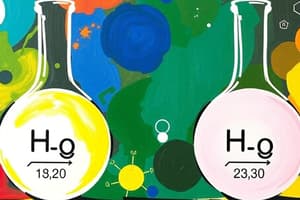Podcast
Questions and Answers
What determines the attachment of a halogen atom in a tetrahedral structured compound?
What determines the attachment of a halogen atom in a tetrahedral structured compound?
- The carbon atom with the least surrounding hydrogen atoms
- The carbon atom with the most surrounding hydrogen atoms (correct)
- The carbon atom with no surrounding hydrogen atoms
- The carbon atom with an oxygen atom attached
What is the primary product of the combustion of alkanes?
What is the primary product of the combustion of alkanes?
- Carbon monoxide
- Methane gas
- Carbon dioxide (correct)
- Water vapor
What type of reaction is the combustion process of alkanes?
What type of reaction is the combustion process of alkanes?
- Oxidation-reduction reaction (correct)
- Substitution reaction
- Addition reaction
- Radical reaction
How does the rate of combustion of alkanes change with increasing molecule size?
How does the rate of combustion of alkanes change with increasing molecule size?
What is harnessed from the significant energy released during the combustion of alkanes?
What is harnessed from the significant energy released during the combustion of alkanes?
What is the function of a hydrocarbon radical in the combustion of alkanes?
What is the function of a hydrocarbon radical in the combustion of alkanes?
Which mechanism involves the replacement of a group of atoms in an organic molecule by another group of atoms following the loss or transfer of electrons?
Which mechanism involves the replacement of a group of atoms in an organic molecule by another group of atoms following the loss or transfer of electrons?
What type of atom acts as an electrophile in halogenation reactions?
What type of atom acts as an electrophile in halogenation reactions?
Which type of substitution involves a nucleophile displacing a leaving group in an organic compound?
Which type of substitution involves a nucleophile displacing a leaving group in an organic compound?
In halogenation reactions, which atomic property affects the reaction rate?
In halogenation reactions, which atomic property affects the reaction rate?
Which stereochemistry aspect may affect the product in halogenation reactions?
Which stereochemistry aspect may affect the product in halogenation reactions?
What is the role of a nucleophile in nucleophilic substitution reactions?
What is the role of a nucleophile in nucleophilic substitution reactions?
Flashcards are hidden until you start studying
Study Notes
Mechanism of Halogenation Reactions
Halogenation is a chemical reaction where one or more hydrogen atoms in an organic compound are replaced with halogens, such as chlorine, bromine, iodine, fluorine, or astatine. This process can occur through various mechanisms depending on the reactants involved. Generally, halogenation occurs via electrophilic substitution. Here's how it works:
Electrophilic Substitution
Electrophilic substitution involves the replacement of a group of atoms in an organic molecule by another group of atoms following the loss or transfer of electrons. In the case of halogenation, a halogen atom acts as an electrophile (a positively charged atom or molecule that seeks to acquire electrons) and substitutes a hydrogen atom in the organic molecule. The reaction rate increases with the increasing atomic size of the halogen atom.
Nucleophilic Substitution
Nucleophilic substitution occurs when a nucleophile (a negatively charged atom or molecule that seeks to donate electrons) displaces a leaving group in an organic compound. This mechanism is less common in halogenation and typically involves the use of a strong nucleophile to displace a halogen atom, which are generally quite stable.
Stereochemistry
In halogenation reactions, the stereochemistry of the starting compound may affect the stereochemistry of the product. For example, if the starting compound has a tetrahedral structure, the halogen atom will attach to the carbon atom that has the most surrounding hydrogen atoms.
Combustion of Alkanes
Alkanes are hydrocarbons with only single bonds between carbon atoms. They are the simplest and most common type of hydrocarbon. Combustion, or complete oxidation, of alkanes produces carbon dioxide and water. Here's how it happens:
Reaction Mechanism
The combustion of alkanes involves the removal of hydrogen atoms from the alkane molecule to form a hydrocarbon radical, which then reacts with oxygen to produce carbon dioxide and water. The reaction is an oxidation-reduction reaction, with the alkane being oxidized and the oxygen being reduced.
Rate of Combustion
The rate of combustion of alkanes depends on several factors, including the structure of the alkane, the concentration of oxygen, and the temperature of the reaction. The rate increases as the size of the alkane molecule increases, as larger molecules have more hydrogen atoms to be removed.
Energy Yield
The combustion of alkanes releases a significant amount of energy, which can be harnessed for various purposes. For example, the burning of fossil fuels like gasoline, diesel, and natural gas is used to power vehicles and generate electricity.
Studying That Suits You
Use AI to generate personalized quizzes and flashcards to suit your learning preferences.




